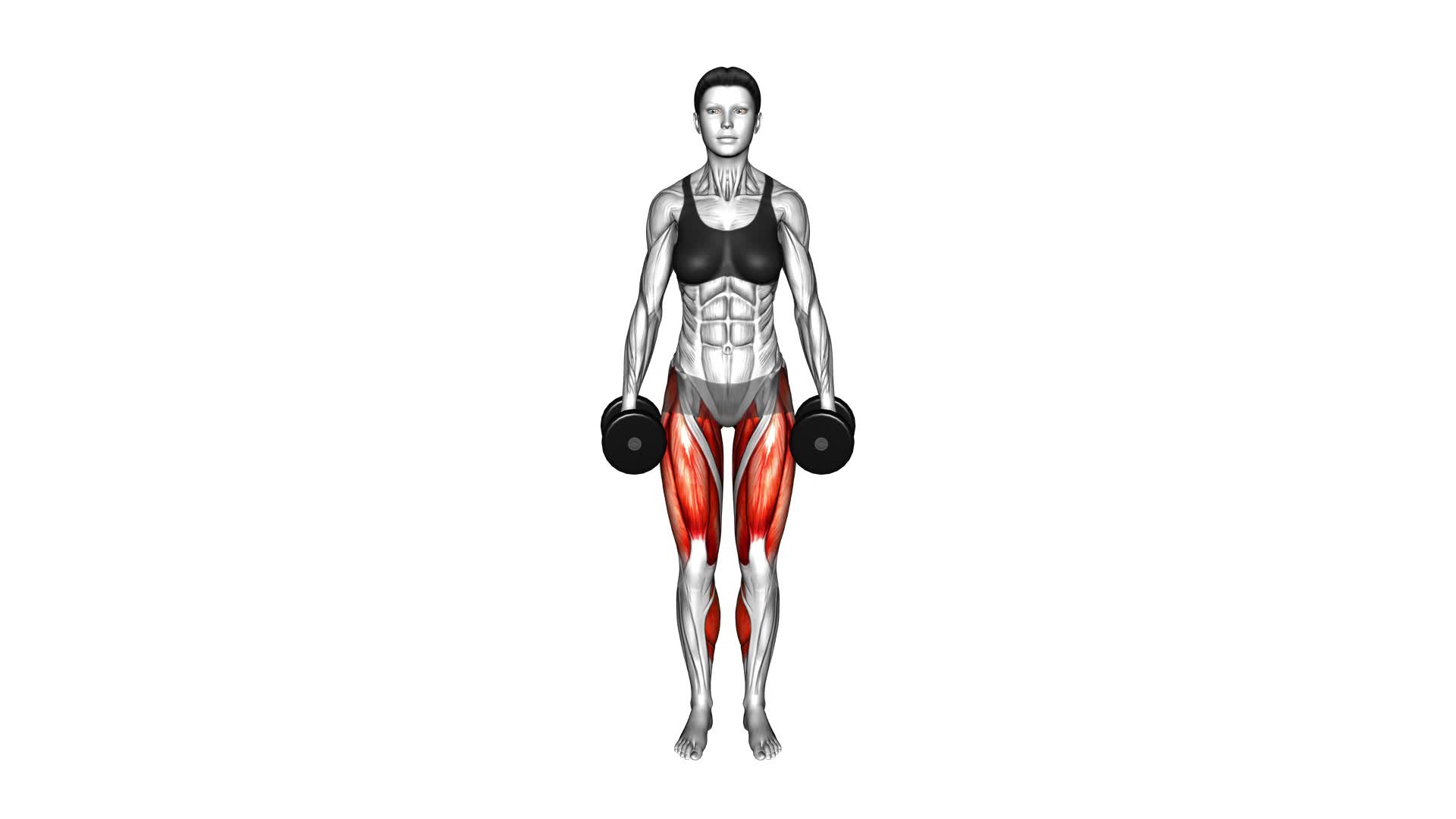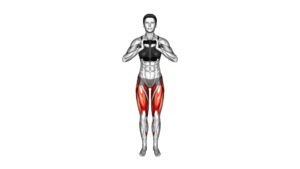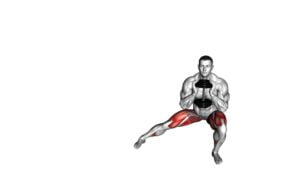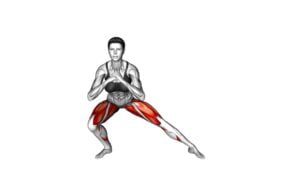Dumbbell Side Lunge (female) – Video Exercise Guide & Tips

Are you looking to tone your legs and glutes? The Dumbbell Side Lunge is a great exercise to add to your routine.
Watch This Exercise Video
In this video exercise guide, we'll show you the proper form and technique, variations and modifications, and common mistakes to avoid.
Plus, we'll share tips for maximizing your results. Get ready to feel the burn and get stronger with this effective workout.
Let's do this!
Key Takeaways
- Dumbbell Side Lunge strengthens glutes and quads.
- It targets lower body muscles.
- Proper form and technique are important to prevent injuries.
- Gradually increasing weight can lead to greater strength and muscle development.
Benefits of the Dumbbell Side Lunge
One benefit of the dumbbell side lunge is that it strengthens your glutes and quads. This exercise specifically targets these muscle groups, helping to tone and build strength in your lower body.
To perform the dumbbell side lunge, you should start by holding a dumbbell in each hand, with your feet shoulder-width apart. Take a step to the side with your right foot, keeping your left leg straight. Bend your right knee and lower your body down, keeping your back straight and chest lifted. Push through your right heel to return to the starting position and repeat on the other side.
When it comes to weight recommendations for the dumbbell side lunge, it's important to choose a weight that challenges you but still allows you to maintain proper form throughout the exercise. Start with lighter weights and gradually increase the weight as you become more comfortable and stronger.
In terms of proper breathing technique, it's recommended to exhale as you push through your heel to return to the starting position and inhale as you lower your body down into the lunge. This helps to engage your core and maintain stability throughout the movement.
Remember to always listen to your body and take breaks as needed.
Proper Form and Technique
To perform the dumbbell side lunge with proper form and technique, you should start by holding a dumbbell in each hand and standing with your feet shoulder-width apart. This exercise is great for targeting your lower body muscles, especially the glutes, quads, and hamstrings.
To maximize intensity and add resistance, you can increase the weight of the dumbbells or use a barbell instead. As you perform the side lunge, make sure to keep your back straight and core engaged. Take a wide step to the side with one foot, while keeping the other foot planted firmly on the ground. Bend the knee of the lunging leg and lower your body down, making sure your knee doesn't go past your toes. Push through the heel of the lunging leg to return to the starting position.
Remember to maintain proper form throughout the exercise to prevent injuries and get the most out of your workout. Once you have mastered the basic dumbbell side lunge, you can explore variations and modifications to challenge yourself further.
Variations and Modifications
Now let's talk about some variations and modifications you can make to the dumbbell side lunge exercise.
One option is to try different lunge positions, such as a curtsy lunge or a reverse lunge, to target different muscles in your lower body.
Another modification you can make is adjusting the weight levels by using lighter or heavier dumbbells, depending on your strength and fitness level.
Experiment with these variations and modifications to challenge yourself and keep your workouts interesting.
Different Lunge Positions
Exploring various lunge positions can enhance your workout routine and target different muscle groups. Instead of sticking to the same old lunges, you can try different lunge techniques and side lunge variations to add variety and challenge to your workouts.
One variation is the lateral lunge, where you step out to the side and lower into a lunge position, targeting the inner and outer thighs.
Another variation is the reverse lunge, where you step back instead of forward, engaging the glutes and hamstrings more.
You can also try the walking lunge, where you take steps forward with each lunge, adding a cardio element to your workout.
By incorporating these different lunge positions, you can maximize the benefits for your lower body muscles.
Now, let's move on to adjusting weight levels to customize your workout even further.
Adjusting Weight Levels
To customize your workout even further, you can adjust the weight levels during different lunge positions and variations. Adjusting weight levels is an effective way to challenge your muscles and make the exercise more intense.
If you find that the dumbbells you're using are too light, you can increase the weight to provide more resistance. On the other hand, if the dumbbells are too heavy and you're struggling to maintain proper form, you can decrease the weight.
Another option is to incorporate resistance bands into your dumbbell side lunges. This will add an extra level of resistance and further engage your muscles.
Remember to listen to your body and choose weights that allow you to perform the exercise with proper technique and without compromising your form.
Common Mistakes to Avoid
Are you making any common mistakes while performing the dumbbell side lunge exercise? To ensure you get the most out of this exercise and avoid potential injuries, here are some tips for success:
- Lack of proper form: One common mistake isn't maintaining proper form throughout the exercise. Make sure to keep your back straight, chest up, and engage your core. Avoid rounding your back or leaning too far forward.
- Incorrect stepping motion: Another mistake is taking too small or too large of a step during the lunge. To perform the exercise correctly, take a wide step to the side and lower your body into a lunge position. Your knee should be directly above your ankle, and your thigh parallel to the floor.
- Neglecting the opposite leg: Many people tend to focus solely on the leg performing the lunge and forget to engage the opposite leg. Remember to push off with your lunging leg and use both legs to bring your body back to the starting position.
- Using improper weight: Using weights that are too heavy can lead to poor form and potential injuries. Start with lighter dumbbells and gradually increase the weight as you become more comfortable with the exercise.
Tips for Maximizing Results
To maximize your results when performing the dumbbell side lunge exercise, focus on engaging your glutes and maintaining proper form throughout the movement. This will help you maximize the intensity of the exercise and ensure that you're targeting the right muscles.
One tip for maximizing intensity is to incorporate resistance by using heavier dumbbells. By increasing the weight, you challenge your muscles more, leading to greater strength and muscle development. Start with a weight that allows you to perform the exercise with proper form, but still feels challenging. As you get stronger, gradually increase the weight to continue pushing your limits.
Another tip is to pay attention to your form. Keep your chest up, core engaged, and shoulders back throughout the movement. This will help you maintain balance and stability, while also targeting your glutes more effectively. Avoid leaning forward or rounding your back, as this can put unnecessary strain on your lower back.
Lastly, make sure to perform the exercise with control and focus. Avoid rushing through the movement and instead, go slow and controlled. This will help you engage your muscles more effectively and prevent any potential injuries.
Sample Dumbbell Side Lunge Workout Plan
Now that you understand the proper form tips for the dumbbell side lunge, let's dive into a sample workout plan.
This plan will include variations for beginners and highlight the benefits of incorporating side lunges into your fitness routine.
Proper Form Tips
Using proper form is essential for a successful dumbbell side lunge workout. Here are some tips to help you maintain proper form and avoid common side lunge mistakes:
- Start with a light dumbbell: Begin with a weight that allows you to perform the exercise with proper form and control. Gradually increase the weight as you become more comfortable and confident.
- Engage your core: Keep your abdominal muscles tight throughout the movement to stabilize your body and protect your lower back.
- Step out to the side: Take a wide step to the side, ensuring that your knee tracks over your toes and your weight is evenly distributed between both legs.
- Keep your chest lifted: Maintain an upright posture throughout the exercise, avoiding any rounding or hunching of the back.
Variations for Beginners
If you're new to dumbbell side lunges, there are several variations you can incorporate into your workout routine to gradually build strength and improve your form.
As a beginner, it's important to start with modifications that suit your fitness level. One modification you can try is performing the side lunge without any weights. This allows you to focus on mastering the proper technique before adding resistance.
Another modification is reducing the range of motion by not lunging as deep. This helps to decrease the stress on your knees and hips.
As you progress, you can gradually increase the weight of the dumbbells to challenge your muscles further. Remember to always listen to your body and make adjustments as needed.
Benefits of Side Lunges
To continue building strength and improving your form, incorporate the benefits of side lunges into your workout routine with a sample dumbbell side lunge workout plan.
Side lunges offer unique advantages compared to traditional lunges, targeting specific muscle groups and providing a challenging workout. Here are some key benefits of side lunges:
- Increased hip mobility: Side lunges require a greater range of motion in the hips, helping to improve flexibility and mobility in this area.
- Stronger glutes and thighs: The lateral movement of side lunges engages the glutes, quadriceps, hamstrings, and adductors, leading to stronger and more toned lower body muscles.
- Improved balance and stability: Side lunges require you to stabilize your body as you shift your weight laterally, helping to improve balance and stability.
- Core activation: Side lunges engage your core muscles as you maintain an upright posture and control the movement, leading to a stronger and more stable core.
Incorporating side lunges into your workout routine can enhance your overall strength, stability, and mobility, making it a great addition to any fitness program.
Frequently Asked Questions
How Many Sets and Reps Should I Do for the Dumbbell Side Lunge?
To get the most out of your dumbbell side lunges, it's important to find the right balance between sets and reps. You want to challenge your glutes and get the benefits of this exercise.
Start with 2-3 sets of 10-12 reps on each leg. This will help you build strength and stability.
As you progress, you can increase the number of sets or reps to continue challenging yourself.
Don't forget to vary your dumbbell side lunge variations for a well-rounded workout.
Can I Perform the Dumbbell Side Lunge Without Weights?
Yes, you can definitely perform the dumbbell side lunge without weights. This modification is a great option if you're just starting out or if you prefer bodyweight exercises.
While using dumbbells adds resistance to the exercise, performing the side lunge without weights still targets your glutes, quads, and inner thighs. It's important to maintain proper form and focus on engaging the targeted muscles.
The benefits of dumbbell side lunges include improved lower body strength, stability, and flexibility.
Should I Do the Dumbbell Side Lunge Before or After My Cardio Workout?
Before or after your cardio workout, you may wonder when to do the dumbbell side lunge. The answer depends on your fitness goals.
If you want to focus on strength and toning, doing the dumbbell side lunge before your cardio workout is ideal. This exercise targets your glutes, hamstrings, and quads, providing numerous benefits such as improved lower body strength and stability.
To maximize results, ensure you maintain proper form throughout the exercise.
Can the Dumbbell Side Lunge Help With Toning My Inner Thighs?
The dumbbell side lunge can be a great exercise for toning your inner thighs. It specifically targets the muscles in that area, helping to strengthen and tone them.
In addition to working the inner thighs, lateral lunges also engage the glutes, quads, and hamstrings for a full lower body workout.
Is It Normal to Feel a Stretch in My Hamstrings During the Dumbbell Side Lunge?
Feeling a stretch in your hamstrings during the dumbbell side lunge is completely normal. This exercise targets multiple muscles, including the hamstrings, glutes, and quadriceps.
As you step to the side and lower into the lunge, your hamstrings are actively engaged to help stabilize and support your body. This can lead to increased hamstring flexibility over time.
Just make sure to listen to your body and stop if you feel any pain or discomfort.
Conclusion
In conclusion, the dumbbell side lunge is a highly effective exercise for targeting the muscles of the lower body, particularly the quads, glutes, and hamstrings.
By incorporating dumbbells into the movement, you can increase the intensity and challenge your muscles even more.
Remember to maintain proper form and technique throughout the exercise to avoid injury.
With variations and modifications available, you can customize the workout to suit your fitness level and goals.
Stay consistent and follow the tips provided to maximize your results.

Author
Years ago, the spark of my life’s passion ignited in my mind the moment I stepped into the local gym for the first time. The inaugural bead of perspiration, the initial endeavor, the very first surge of endorphins, and a sense of pride that washed over me post-workout marked the beginning of my deep-seated interest in strength sports, fitness, and sports nutrition. This very curiosity blossomed rapidly into a profound fascination, propelling me to earn a Master’s degree in Physical Education from the Academy of Physical Education in Krakow, followed by a Sports Manager diploma from the Jagiellonian University. My journey of growth led me to gain more specialized qualifications, such as being a certified personal trainer with a focus on sports dietetics, a lifeguard, and an instructor for wellness and corrective gymnastics. Theoretical knowledge paired seamlessly with practical experience, reinforcing my belief that the transformation of individuals under my guidance was also a reflection of my personal growth. This belief holds true even today. Each day, I strive to push the boundaries and explore new realms. These realms gently elevate me to greater heights. The unique combination of passion for my field and the continuous quest for growth fuels my drive to break new ground.







